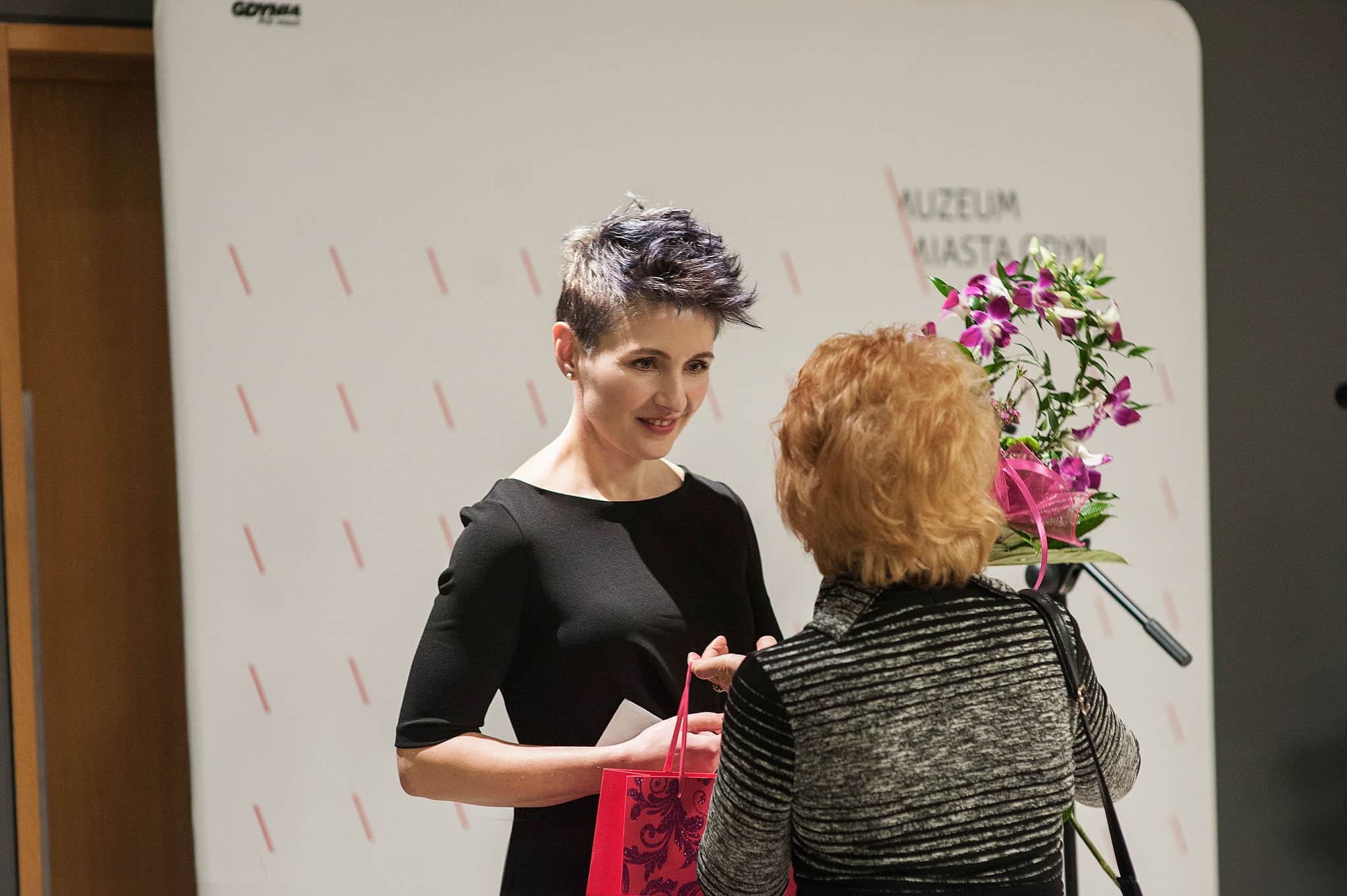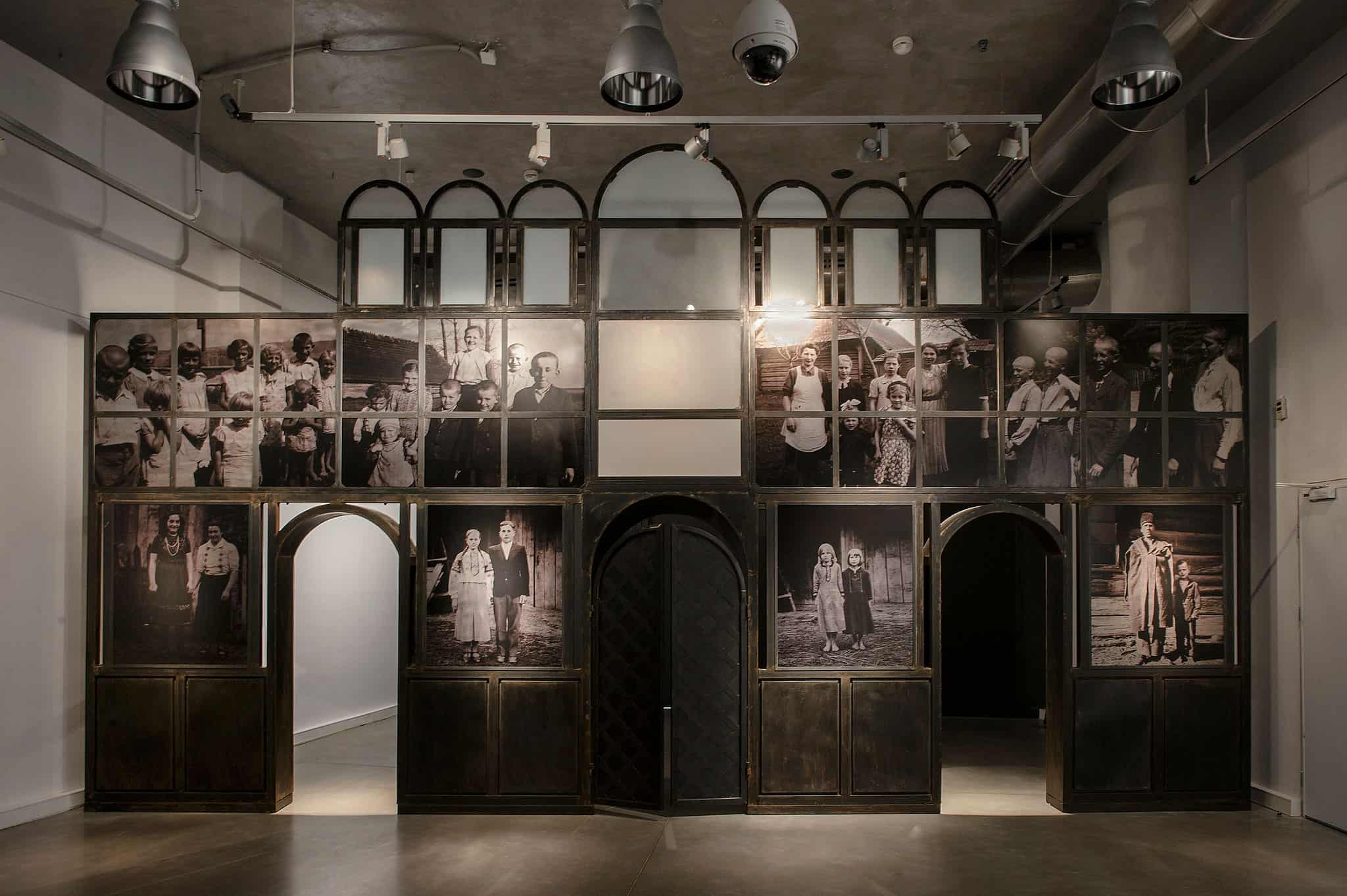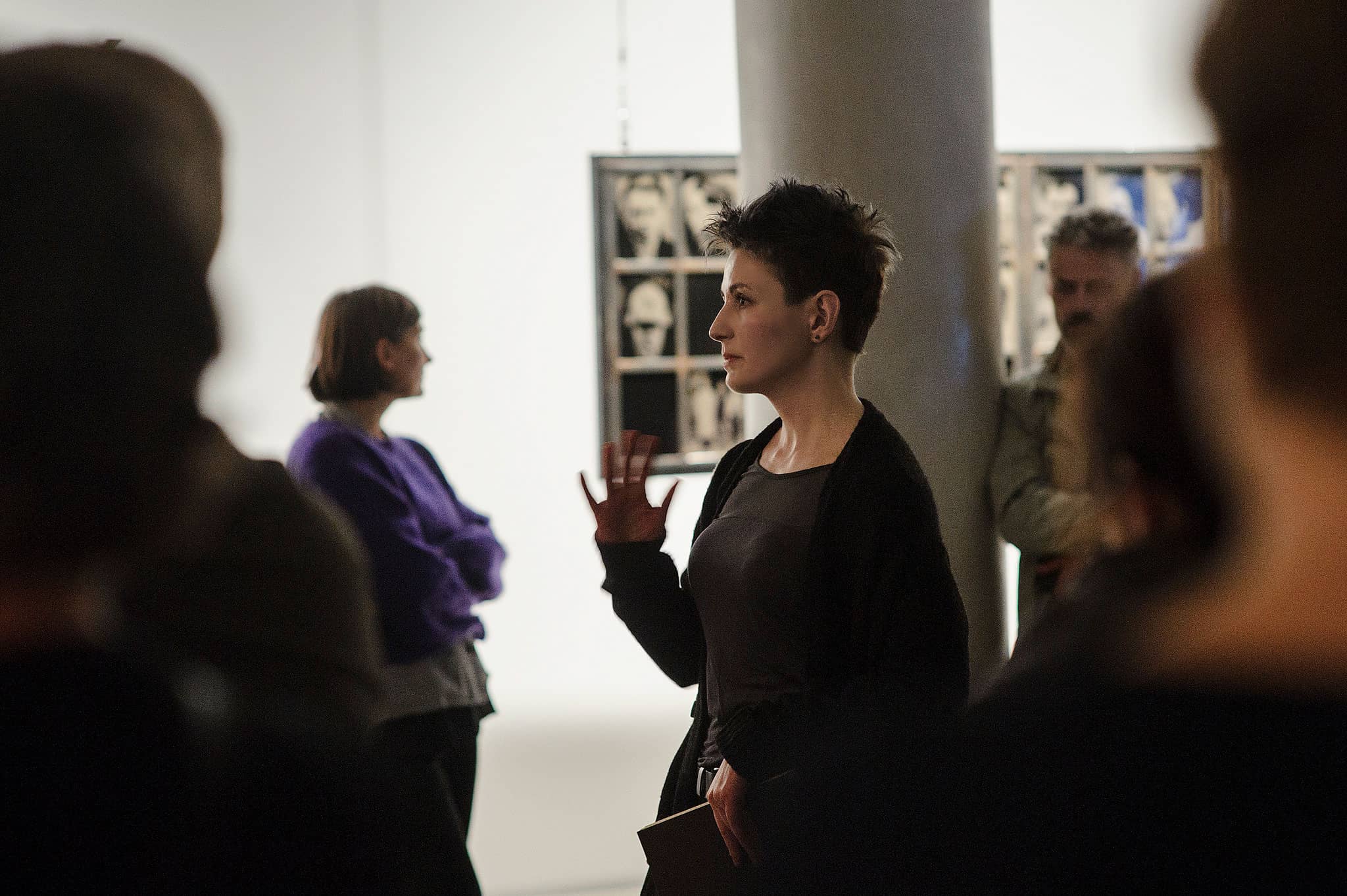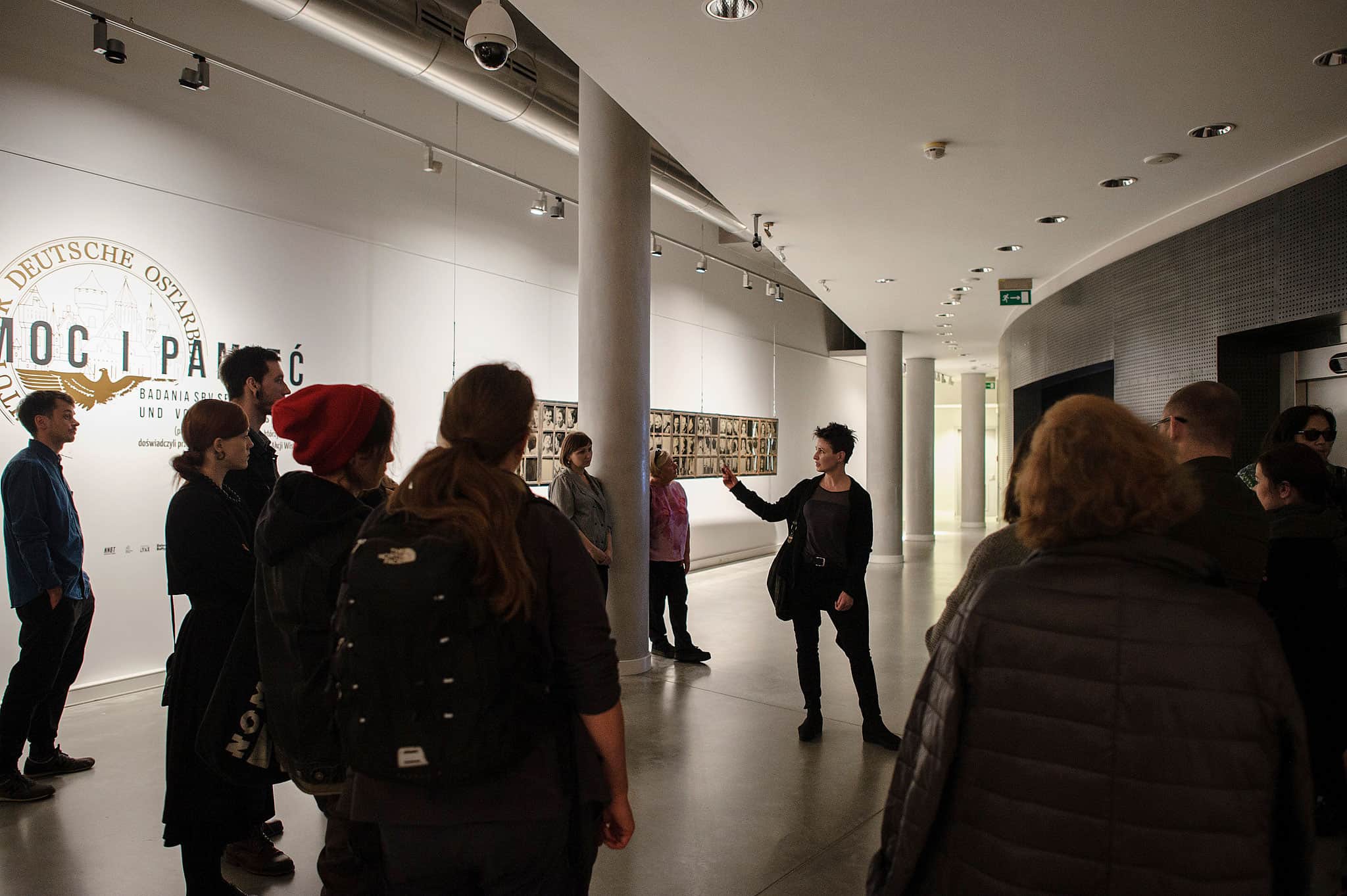Discovered documents, archived materials and memories form the foundations of Dorota Nieznalska’s works. The artist utilises all of these in the quest for her own identity, often outside of her comfort zone. Dorota Nieznalska is mostly known for the critical works. These are installations, sculptures, photographs, video materials and video installations. Recently we had the chance to talk to Dorota about her latest exhibition “Violence and memory. Research by the SRV Sektion Rassen- und Volkstumsforschung” at the Gdynia City Museum.

Dorota Nieznalska, ‘Violence and memory. Research by the SRV Sektion Rassen- und Volkstumsforschung’ – exhibition, the Gdynia City Museum, photo: Bogna Kociumbas
Daga Ochendowska: What is the most common reaction to the name Nieznalska these days?
Dorota Nieznalska: Everything depends on who I interact with, whether it is a regular person or an institution, but to be honest, my name often proves to be an impenetrable barrier preventing me from collaborating with selected entities. This happens for instance when I want to access certain archives or documentation, which I would later like to use as core elements in my exhibitions. Nevertheless, I have to admit that private individuals have very positive attitudes towards me. I know many people who are passionate about everything I do and follow my activities in detail. I often hear positive reactions from my viewers, which encourages me to continue working. Today I came back from a two-day workshop which I delivered in Wrocław. The workshop participants came from various parts of Poland and even from abroad just because they wanted to hear what I had to say and meet me in person.

Dorota Nieznalska, ‘Violence and memory. Research by the SRV Sektion Rassen- und Volkstumsforschung’ – exhibition, the Gdynia City Museum, photo: Bogna Kociumbas
D.O.: What was the topic of this workshop?
D.N.:I talked about the methodology of conducting research projects. I have been working on my own research projects for nearly ten years, and throughout this time I designed my research methodology. I wanted to teach young people these original methods of analytical work which are the basis for a well-rounded research project.
D.O.: Research methodology is what I wanted to discuss with you. For a long time, you have been working exclusively with archived materials and documents. The exhibition in Gdynia where you present photographs found in the Institute [Institute of Ethnology and Cultural Anthropology of the Jagiellonian University] constitutes a perfect example of what you do. What is it like to work with these materials? You just mentioned that various institutions do not always welcome you. Given this, how do you manage to access materials you want to research?
D.N.: There is an enormous amount of materials you collect while working with archival sources. What I have in mind are not only archived materials but knowledge in general, which complements the projects or reveals certain hidden references and contexts. This is why I also have to focus on interviews, spoken reports, photographs and extended bibliographies.

Dorota Nieznalska, ‘Violence and memory. Research by the SRV Sektion Rassen- und Volkstumsforschung’ – exhibition, the Gdynia City Museum, photo: Bogna Kociumbas
D.O.: This seems to be truly in-depth research…
D.N.: You are right, this is exactly so. However, a lot depends on the project itself. Since I am interested in micro stories and not so much the general history recorded in accessible sources and allowed to be disclosed, my task is far more complex. The main difficulty is finding information which has not been recorded comprehensively, has been disclosed to the wider public only as tiny fractions of available knowledge or information which is unknown to virtually anyone. Sometimes, when I am so successful to discover facts that have been forgotten a long time ago or overlooked by previous researchers I am deeply satisfied. Whenever I come upon an interesting piece of information or an exciting phenomenon I go further and analyse the topic from multiple perspectives trying to discover more complex parts of a given story. I start preparing a specific work only when my level of understanding of the context is high enough. At the same time I look for the perfect medium which would suit my intentions. When I search for archival sources I usually cooperate with institutions. Working with institutions is difficult for me and usually I fail to achieve what I want. However, I have to admit that recently this has not always been the case as more institutions seem to approach me with understanding.

Dorota Nieznalska, ‘Violence and memory. Research by the SRV Sektion Rassen- und Volkstumsforschung’ – exhibition, the Gdynia City Museum, photo: Bogna Kociumbas
D.O.: Are there any exceptions?
D.N.: Sure, there are. One of them was my partnership with the Institute of Ethnology and Cultural Anthropology at the Jagiellonian University. When I worked on my exhibition “Violence and Memory. Research by the SRV Sektion Rassen- und Volkstumsforschung”, which is currently on show at the Gdynia City Museum, I had a meeting with Marcin Brocki (the Head of the Institute) who seemed delighted with the fact that someone was interested in researching materials from the Institut für Deutsche Ostarbeit. [from the editor: it was a German research branch at the Jagiellonian University in Kraków, established by fascists in 1940.] He was more than willing to give me access to materials I wanted to work with. The situation was, unfortunately, very different when I wanted to research materials from IDO racial ethnology section which are archived in the Archive of the Jagiellonian University. Gaining access to them was a real struggle. I used multiple negotiation strategies hoping to convince the Archive Director to allow me to conduct my research. Although I tried extremely hard, I am sure that there is so much more I could have learned had I been allowed to look at everything I wanted. Some of those materials are “blocked for access”. This applies, for example to portraits of children collected by the racial ethnology section. The Archive Director justifies their unavailability to the public quoting the need to protect personal data and general well-being of people who underwent compulsory racial examinations conducted by IDO.

Dorota Nieznalska, ‘Violence and memory. Research by the SRV Sektion Rassen- und Volkstumsforschung’ – exhibition, the Gdynia City Museum, photo: Bogna Kociumbas
D.O.: Why are you interested in this specific region and the local community?
D.N.: I became interested in it about six years ago when I was looking for information relating to my own identity. Back then I already started to prepare projects relating to East Prussia (today’s Warmia and Masuria), which is the region my grandparents lived in. Since that time my interest in history, memorial sites, forgotten locations and unwanted heritage grew stronger and the areas of my research became much more complex. Currently I am not working only around topics related to my own identity, but research many other topics and contexts.
D.O.: Do you know if anyone recognised their family in the photographs presented at the exhibition?
D.N.: I would say “almost recognised”. There was a lady from Wróblik Królewski who came to the vernissage in Gdynia. On the iconostasis I created you can see archival photographs of people from this village. I had an opportunity to talk to this lady and she told me that her parents indeed underwent racial examinations conducted by IDO. Later on, I talked to a few older people about Operation Vistula. I find such meetings extraordinary. During these moments I see that the history I try to learn so hard really comes and speaks to me through people I meet.

Dorota Nieznalska, ‘Violence and memory. Research by the SRV Sektion Rassen- und Volkstumsforschung’ – exhibition, the Gdynia City Museum, photo: Bogna Kociumbas
D.O.: This part of Polish history is particularly important to you personally. The exhibition retold Operation Vistula, which affected your family.
D.N.: I dedicated the exhibition to my family and prepared it in memory of people who were forced to leave their homes for good during Operation Vistula in 1947. The operation itself was clearly ethnic cleansing. Therefore it is classified as a crime against humanity committed by the communist authorities of the Polish state, directed against those living in south-eastern Poland. Besides disclosing unknown materials from the IDO archives, another aim of the exhibition is to commemorate and elaborate on the social groups who were resettled during the armed campaign and ethnic cleansing of 1947. We have to remember that these activities annihilated the cultural heritage of these regions, which will never be restored.
D.O.: Did your family live in the area where the Institut für Deutsche Ostarbeit carried out its examinations and research?
D.N.: I think of this story as part of my family history indeed, in spite of the fact that my family members, who survived Operation Vistula, did not participate in the examinations. This is why you will not find any pictures of my family at my exhibition. My goal was by far not to tell everyone my private story. Instead, I strived to create universal narration around this part of our history and emphasise that Operation Vistula was a definite end to many cultures present at that time in south-eastern Poland.

Dorota Nieznalska, ‘Violence and memory. Research by the SRV Sektion Rassen- und Volkstumsforschung’ – exhibition, the Gdynia City Museum, photo: Bogna Kociumbas
D.O.: Nowadays it is difficult to find a person who is aware of such a campaign, even in Poland itself.
D.N.: True, indeed. I think it is because this part of our history is being denied and discussions around it are constantly avoided. The whole Operation Vistula is kind of a taboo due to the considerable violence and consequences of this political decision. The Polish People’s Republic authorities at that time carried out massive resettlement campaign to clear these areas by simply throwing out people from their homes and moving them away against their will.
D.O.: Why did these people have to move away at exactly that time?
D.N.: This pacification campaign was directed against the Ukrainian Insurgent Army operating within the territory of Poland, which was economically supported by civilians inhabiting the area of the army’s operation. In order to break down this support system and get rid of the “Ukrainian Insurgent Army bands”, the communist authorities of Poland decided to resettle entire ethnic groups from the vulnerable area. They resettled the Boykos, the Lemkos, mixed Polish-Ukrainian families and moved the majority of them to the territories “recovered” after the World War II.

Dorota Nieznalska, ‘Violence and memory. Research by the SRV Sektion Rassen- und Volkstumsforschung’ – exhibition, the Gdynia City Museum, photo: Bogna Kociumbas
D.O.: There was also a substantial amount of propaganda around this research campaign.
D.N.: The logo which you can see on the poster advertising the exhibition in Gdynia comes from the cover page of Die Burg. This was the crucial paper for IDO and the main tool of propaganda. It featured articles by IDO employees in which they discussed how much behind occupied Polish territories were in terms of cultural development or tried to prove the eternal presence of the Germans in the “Eastern territories”, who embarked on, as they put it, “the German civilisation mission”.
D.O.: Did you learn any fascinating stories while researching all these materials?
D.N.: The institute was divided into eleven sections and the crucial ones were racial ethnology and reconnaissance section supervised by Austrian anthropologists. Their employees embarked on field trips to conduct their research. Their destinations included the ghetto in Tarnów, Podhale, the Sądecki region, and Lemko villages. Some IDO projects and analyses involved goals that the German authorities wanted to achieve in Central and Eastern Europe after the war. These were both economic and ethnic: the separation of ethnic groups and the segregation of conquered people. Soon after starting their expeditions the researchers realised that they were working in an incredibly multicultural background. This phenomenon of multiculturalism practically applied to the entire territory of the General Government. There is an interesting story relating to the image showing children from Haczów, which you can see in my installation. This group attracted attention because IDO researchers noticed that most of the young inhabitants of Haczów had blonde hair and blue eyes. They concluded that Swedish colonialists must have been living in this village earlier.

Dorota Nieznalska, ‘Violence and memory. Research by the SRV Sektion Rassen- und Volkstumsforschung’ – exhibition, the Gdynia City Museum, photo: Bogna Kociumbas
D.O.: This is a remarkable story.
D.N.: The national socialist propaganda went one step further and ordered a book titled “Zew przodków” (The Voice of the Ancestors) by Emilian Haczowski (unfortunately we do not know who the real person behind this name was). This is a typical propaganda novel telling a naive story about Germanic peoples, exactly about a single Germanic tribe, which came to the territory of Poland with a mission to bring civilization to this area. They had to overcome many obstacles and even clear forests create decent space to live. They were positivist in their attitude because they followed the principle of kindness, as opposed to the barbarian Poles who were nothing more than savages when compared to the Germanic people.
The book was written mainly as a consequence of finding the children from Haczów, who all had features characteristic of the Aryan “clean race”. These features made them “wanted”. As representatives of the “clean race” in accordance with the national socialist ideology, they were often kidnapped and forcibly Germanised. Last year I organised an exhibition “Collection of Institut für Deutsche Ostarbeit” shown at the National Museum in Gdańsk, which presented the story of Lebensborn e.V., an organization in charge of several orphanages in the Third Reich. My main focus in that exhibition were children taken away from their parents because of their “perfectly Aryan” appearance, who were classified by Nazi officials as representatives of the “clean race”.

Dorota Nieznalska, ‘Violence and memory. Research by the SRV Sektion Rassen- und Volkstumsforschung’ – exhibition, the Gdynia City Museum, photo: Bogna Kociumbas
D.O.: It seems that your work never ends because the materials you use to prepare one exhibition introduce new threads which you present at subsequent events. I think you will have a lot to present during the next dozen of years.
D.N.: I agree with you. However, I want to be honest and admit that I feel some kind of crisis is upon me. My recent exhibitions made me so emotional and apprehensive. During the opening of the exhibition at the Gdynia City Museum, I said that I am terrified with the reality, nationalism, growing antisemitism and hatred. It seems that when we try to discover events from the past we, in fact, search for descriptions of reality which in many aspects is very similar to what surrounds us today.

Dorota Nieznalska, ‘Violence and memory. Research by the SRV Sektion Rassen- und Volkstumsforschung’ – exhibition, the Gdynia City Museum, photo: Bogna Kociumbas
D.O.: Thinking about what you just said – what is it like to work with such depressing topics?
D.N.: I am fascinated with these topics, but I am not fixated on them and always try to look at things from a perspective and analyse what I read without forming superficial opinions.
I really hope that my exhibitions encourage deeper reflection about the dangers of hatred, classifying people into better and worse categories or negative attitudes towards certain races. I would like people to realise that there is no good in limiting someone’s freedom, excluding certain groups or individuals and violating their rights. Mercilessness and cruelty is never the path we should follow.
Written by Daga Ochendowska

Dorota Nieznalska, ‘Violence and memory. Research by the SRV Sektion Rassen- und Volkstumsforschung’ – exhibition, the Gdynia City Museum, photo: Bogna Kociumbas





